Our
Facilities
We offer an academic, sporting, co-curricular and personal development programme that affords students every opportunity to grow in knowledge, self-confidence, skill and understanding.
Classrooms
we believe in harnessing the power of technology to create an immersive and dynamic learning environment for our students. This commitment is exemplified through the integration of cutting-edge innovations in our smart room, classroom, and playground spaces. These spaces are meticulously designed to foster creativity, critical thinking, and holistic development in our students.
SMART ROOM: The heart of our technological ecosystem lies in the smart room, a versatile space that seamlessly combines advanced technologies with interactive learning experiences. Here, students have access to a range of digital tools and resources, creating an environment that encourages collaboration, problem-solving, and independent exploration.
CLASS ROOM: Our classrooms are thoughtfully designed spaces that prioritize comfort, collaboration, and student-centric learning. Here, students are encouraged to question, explore, and engage actively in the learning process.
PLAYGROUND: The playground at our school is more than just a recreational area; it is an extension of our commitment to holistic development. It provides students with opportunities for physical activity, social interaction, and creative expression.
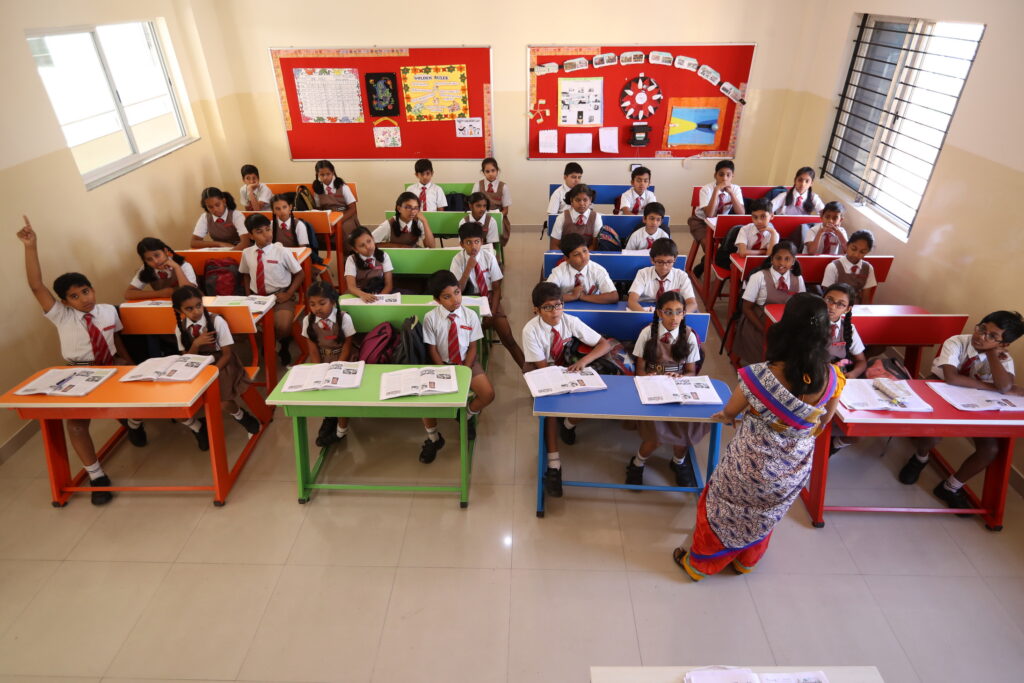
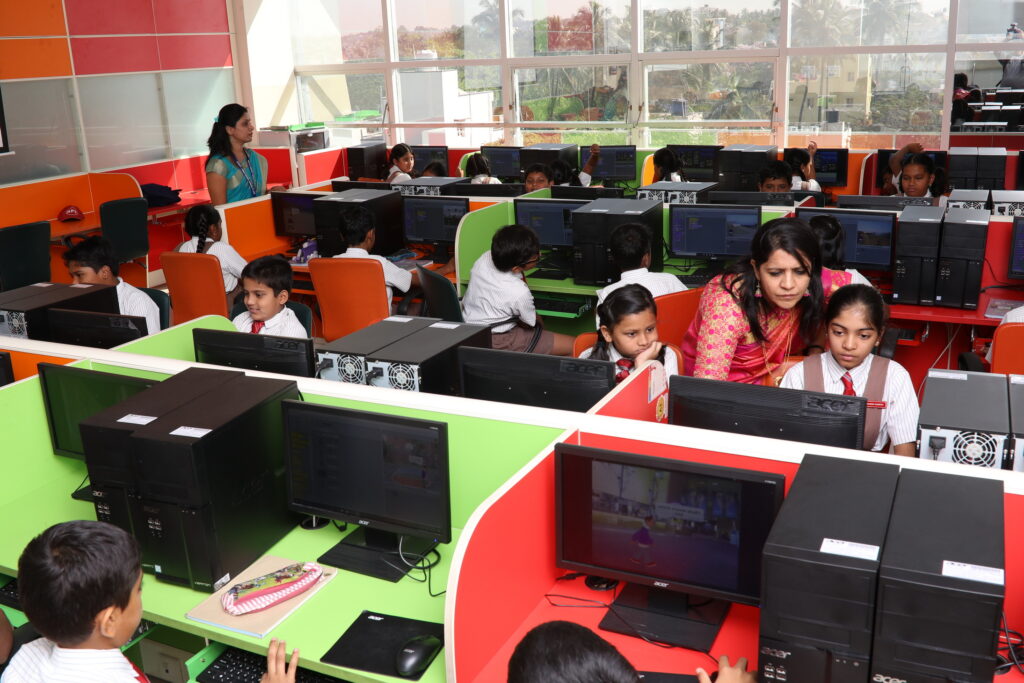
Computer Lab
Computer Lab, a space that has witnessed a remarkable evolution in the past ten years. This dedicated facility has been instrumental in shaping the digital journey of students from Grade 1 to 12. Over the years, it has transformed into a dynamic learning environment, keeping pace with the ever-changing landscape of technology.
In the early years, the Computer Lab was primarily equipped with desktop computers, providing students with their first taste of the digital world. Basic applications and educational software were introduced, offering fundamental computer literacy skills. Students were introduced to typing, basic word processing, and interactive educational games tailored to their grade level. Students learned to navigate operating systems, explore web-based resources, and engage in online research. Coding and digital design became prominent features in the curriculum. Students gained hands-on experience in programming languages. Nurtured critical thinking, problem-solving, and creativity.
From basic computer literacy to immersive, personalized learning experiences, our lab has been at the forefront of this evolution. We look forward to embracing the future and empowering our students with the tools they need to succeed in an increasingly digital world.
Science Laboratory
Discover, create and innovate:
Laboratories’ -a space where ideas take shape, dreams become prototypes, and innovation thrives. An exciting journey of exploration and discovery!
Middle School Composite Lab:
We believe in nurturing young minds to become innovators and problem solvers. Our Middle School Composite Lab is designed to ignite curiosity and creativity in every student. This dynamic space is where science, technology, engineering, arts, and mathematics converge, offering an enriching learning experience.
Students are provided with the opportunity to delve into various fields of study. From designing prototypes to conducting experiments, this space encourages a holistic approach to education.
Senior Secondary Science Lab:
We take pride in providing our students with an exceptional learning environment. Senior Secondary School Science Lab is a testament to our commitment to fostering a deep passion for scientific inquiry. Students are provided with opportunities to move beyond textbooks and engage in practical, experiential learning. This hands-on approach enhances comprehension and retention of scientific concepts.

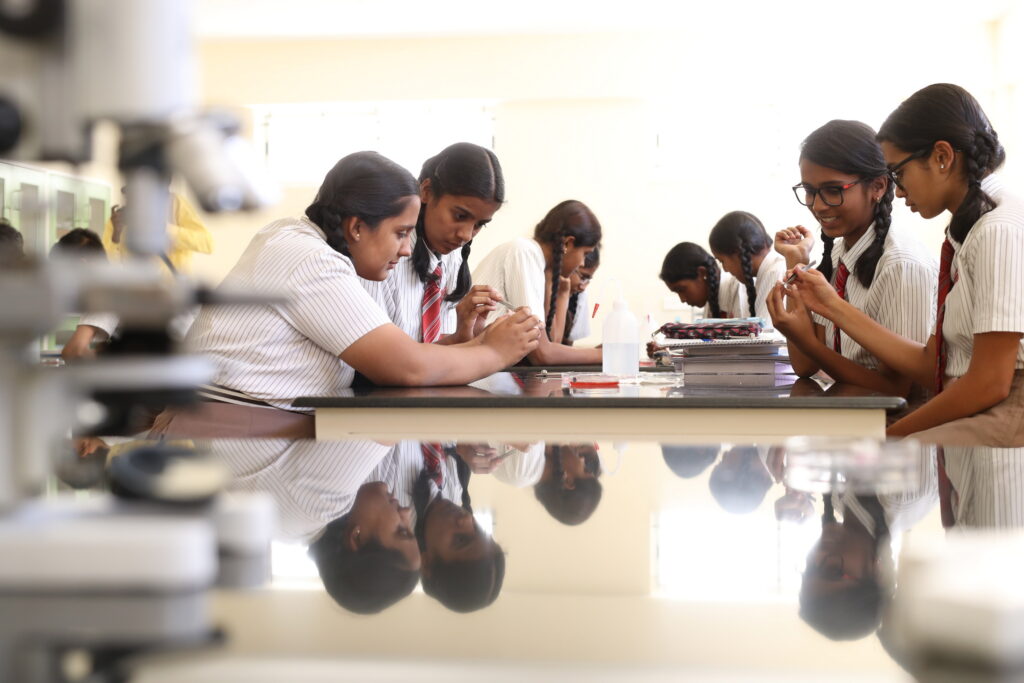
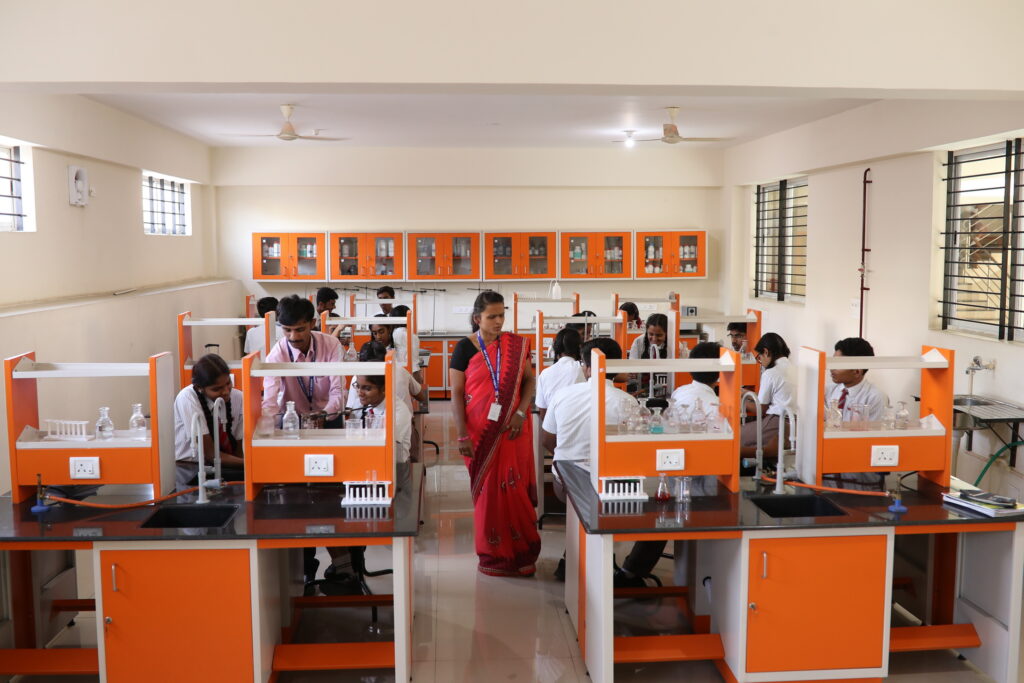
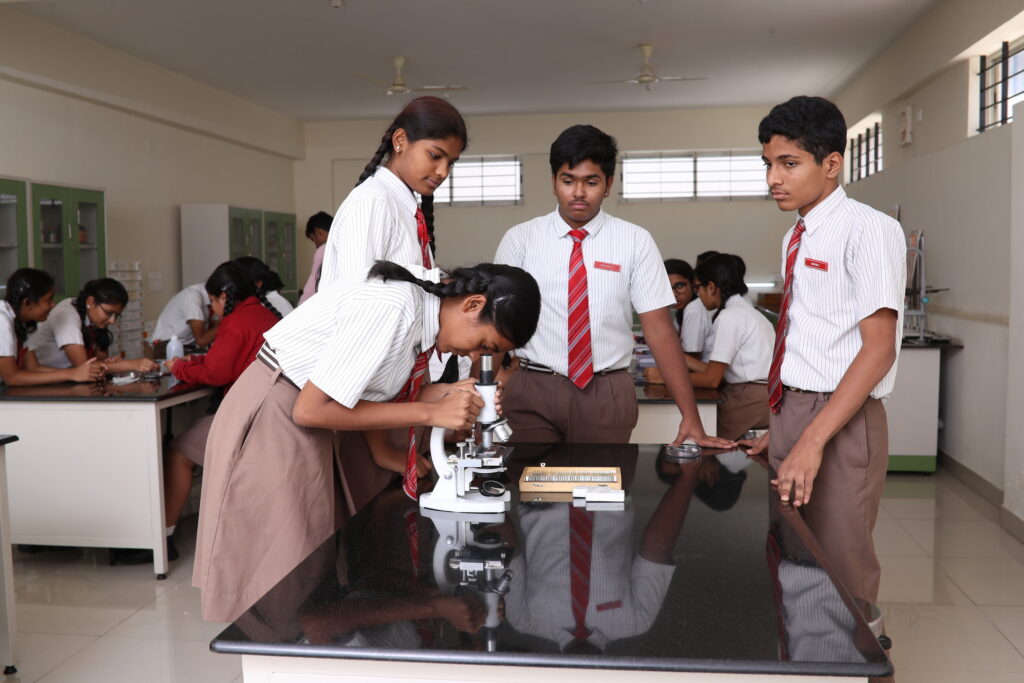
Features
Advanced Equipment:
Our lab is equipped with the latest instruments and apparatus, enabling students to engage in hands-on experiments across various scientific disciplines. From physics, chemistry and biology, which provides a platform for practical exploration and discovery.
Safety First:
The safety of our students is our top priority. Our lab adheres to stringent safety protocols, ensuring a secure environment for experimentation. Students are trained in lab safety procedures and supervised by experienced faculty members.
Students of senior secondary classes from 2019 onwards have been successfully equipped with skills from our lab, are well-prepared for further studies in various scientific disciplines. Many of our alumni have pursued successful careers in fields such as medicine, engineering, and research.
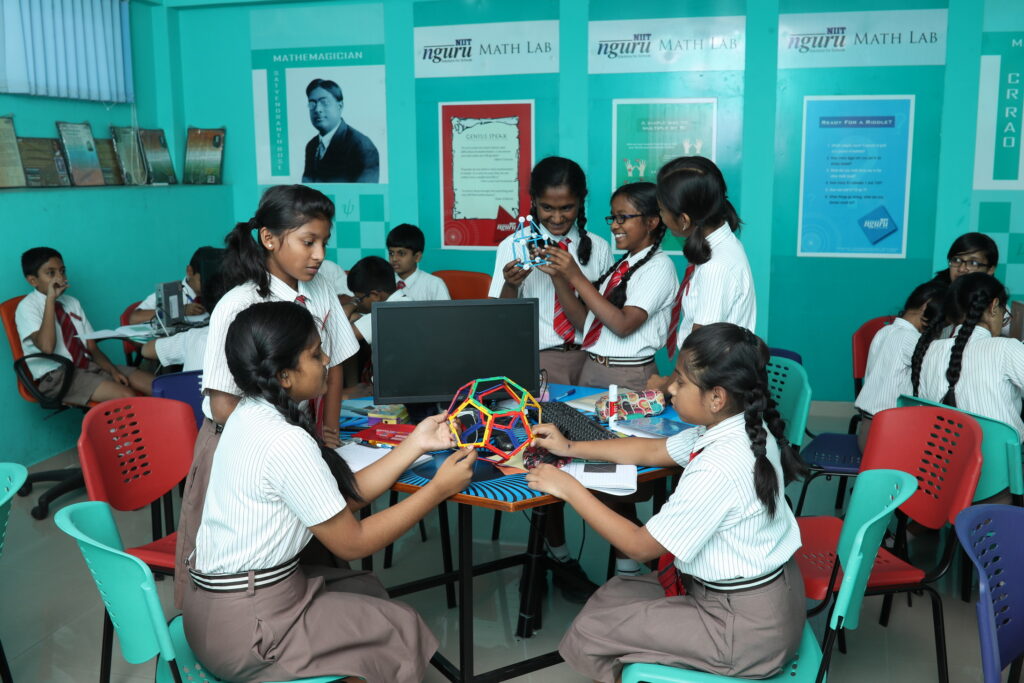
Maths Lab
Calculus Clan: A Fraction Ahead:
Calculus Clan – A Math Lab for grade 3 to 12 is not just a room filled with textbooks and calculators; it’s a vibrant hub where students embark on a journey of discovery, creativity, and problem-solving. Here, we believe that mathematics is not just a subject but a way of thinking, and the Calculus Clan is designed to instil this perspective in every student who walks through its doors.
Features:
Enhance the clarity on concepts
Fun activities with the aid of manipulatives is equipped with cutting-edge technology, interactive learning tools, and a vast array of mathematical resources.
This allows our students to engage in hands-on activities, experiments, and projects that make abstract mathematical concepts tangible, and relatable.
The Calculus Clan takes pride in nurturing the next generation of mathematicians and problem solvers. We encourage participation in math competitions.
Library/ Media Centre
In order to encourage students, teachers, and other staff members to foster reading habits and learning, the National Public School, Kengeri, Library is a well-organized collection of fiction, non-fiction, reference, encyclopaedia, journals, periodicals, newspapers, and teaching materials.
The number of books at the school has increased throughout the years to about 10,000. The books’ extensive subject coverage enlightens young brains. It contains some of the most well-known and enduring works of fiction and non-fiction in the languages of English, Kannada, Hindi, and French. Subscriptions to magazines, journals, and other periodicals provide young minds with resources for additional research.
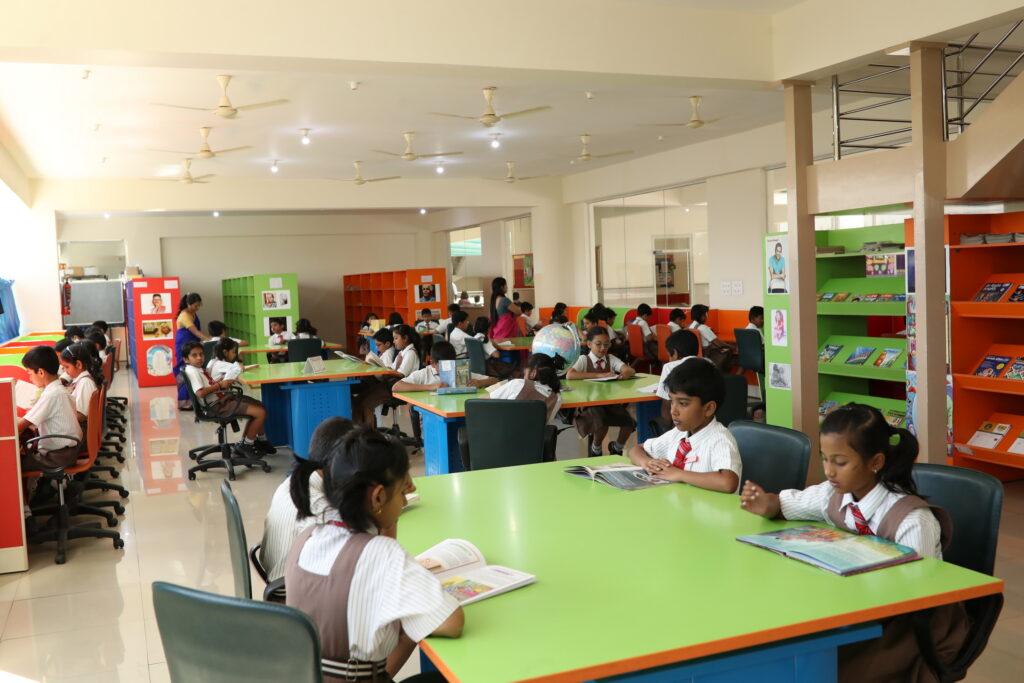
To spark curiosity and engage young brains, a variety of age-appropriate activities are regularly conducted. Few activities are;
- DEAR Programme – (Drop Everything and Read by using A-Z Series ) This programme has set of E-books (A-Z Series) that is aligned according to the age group of students. The content of these E – books helps students to sharpen their vocabulary critical thinking and to analyse the given content.
- Word Search – Scramble
- Significance of the day
- Nobel Laureates
- Know your author
- Book review
- Story narration
- Shedding light on current events
The NPS Kengeri Library is a wealth of knowledge that significantly contributes to enhancing pupils’ self-confidence by expanding their vocabulary.
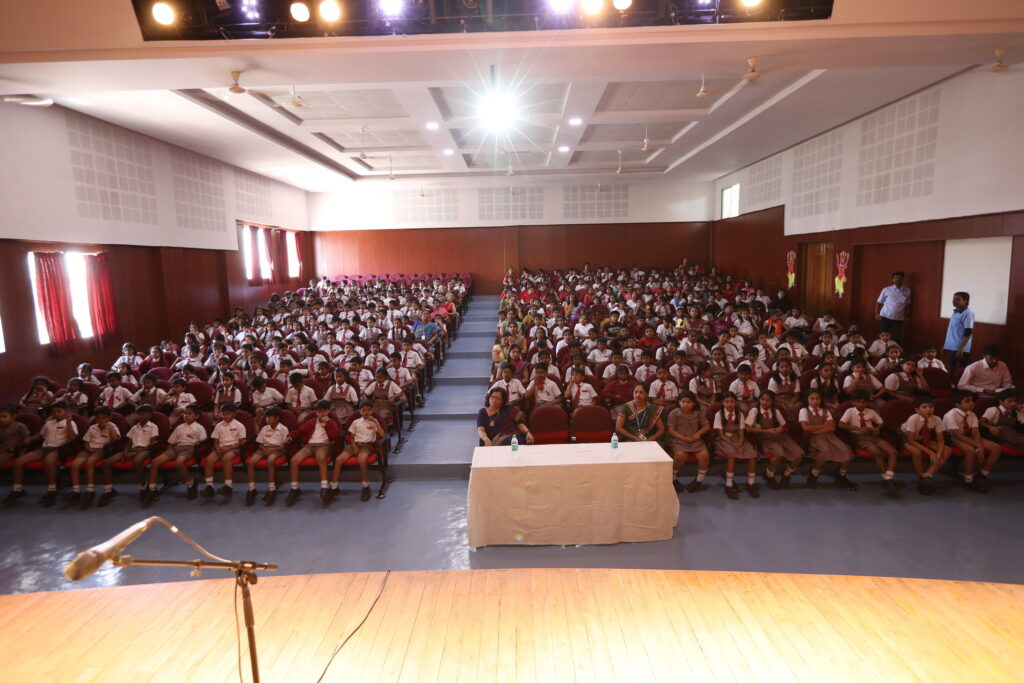
Auditorium
The school auditorium is a central and essential space within an educational institution. It serves a multifaceted purpose, encompassing both functionality and aesthetics. Here’s a description capturing our two auditoriums – Basement and the Main Auditorium:
Architectural Splendor: The school auditorium often stands as a showcase of architectural prowess. With its impressive facade, high ceilings, and striking design, it is a testament to the institution’s commitment to providing a well-rounded education.
Seating and Capacity: Upon entering the auditorium, rows of comfortable, cushioned seats or benches fan out in a semi-circular arrangement, focusing all attention on the stage. The seating capacity can vary, accommodating a large audience for events like school plays, concerts, lectures, workshops, national festivals and assemblies.
Stage and Platform: At the front, the stage takes center stage – a polished, elevated platform equipped with curtains, lighting, and sound systems. It’s the focal point where students, teachers, and guests showcase their talents, whether through dramatic performances, musical recitals, or academic presentations.
Acoustic Excellence: The essence of a school auditorium lies in its superb acoustics. Walls and ceilings are designed to minimize sound reflection and maximize sound distribution, ensuring that even the softest notes or words are clearly heard by every member of the audience.
Aesthetic Elements: Aesthetic elements like decorative curtains, banners, and artwork contribute to the auditorium’s charm. It features the school’s logo or motto, celebrating the institution’s heritage and values.
Technological Advancements: The modern school auditorium is equipped with advanced audio-visual technology, including projectors, screens, microphones, and lighting controls. This technological backbone supports not only educational presentations but also entertainment events.
Multipurpose Functionality: Versatility is key to the school auditorium’s essence. It adapts to a myriad of uses, from academic lectures and award ceremonies to talent shows and community gatherings. Its adaptability makes it an integral part of school life.
Sense of Community: The auditorium often serves as a place where the school community comes together. It is a hub for shared experiences, where students, teachers, and parents unite to celebrate achievements and milestones.
In conclusion, the school auditorium embodies the heart and soul of a school, where education and the arts converge, where ideas are shared, and where memories are created. Its essence lies in its ability to inspire, educate, and entertain, fostering a sense of togetherness within the school community.
The Dance Curriculum
Dance, a universal language that transcends boundaries and cultures, has been a means of human expression for centuries. Whether classical ballet, hip-hop, contemporary, or folk dances, this art form speaks volumes through movement, rhythm, and emotion. To master this captivating medium and refine one’s skills, a structured Dance Curriculum is paramount. It offers a comprehensive, well-organized roadmap to explore the world of dance, guiding students from beginners to professionals in their quest for artistic expression and physical mastery.
The Structure: A Dance Curriculum is typically structured to cater to various age groups and skill levels. It can span from early childhood dance classes to rigorous professional training. It encompasses a wide range of styles, techniques, and genres, allowing students to discover their own passion within the art form. The curriculum is divided into levels, each building upon the previous one, ensuring a logical and safe progression.
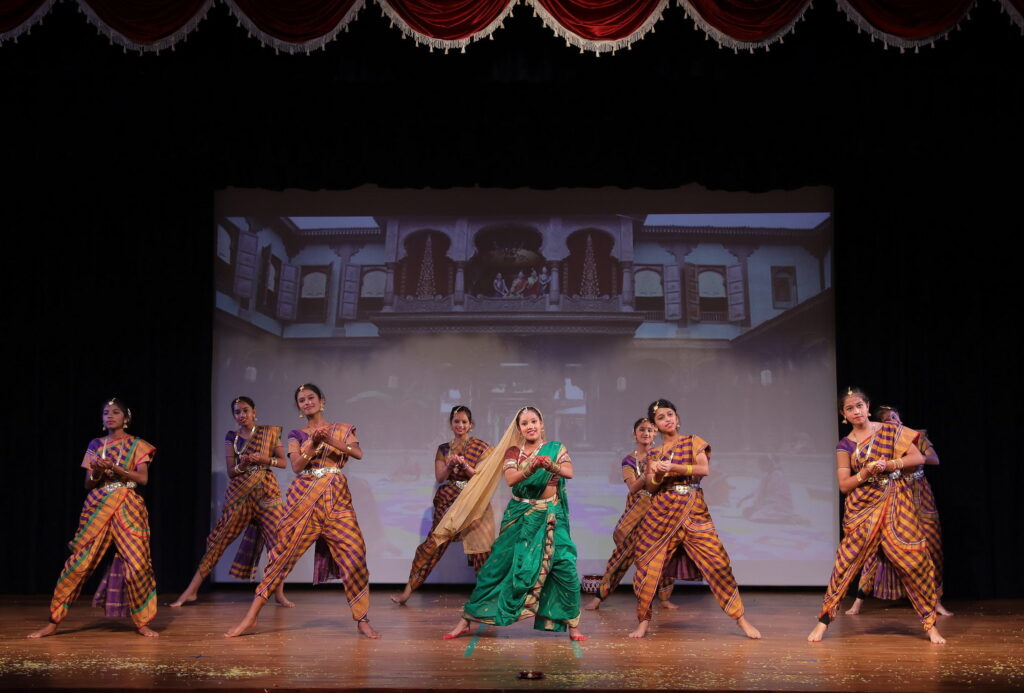
Fundamental Techniques: The foundation of any Dance Curriculum lies in teaching fundamental techniques. This includes posture, body alignment, balance, and basic movements like pliés and tendus in ballet or foundational steps in other dance forms. These fundamental skills are essential for building strength, flexibility, and control.
Dance Styles: Dance curricula cover a multitude of styles, from classical to contemporary. Students are exposed to various genres such as ballet, jazz, hip-hop, contemporary, tap, and traditional folk dances. This diversity allows them to explore and discover their preferences and strengths.
Choreography and Creativity: As students’ progress, they delve into choreography, learning how to create their own dance routines. This aspect of the curriculum nurtures creativity, artistic expression, and the ability to convey emotions through movement.
Performance and Stagecraft: Dance is as much about performing as it is about mastering steps. Dance curricula often include performance opportunities where students learn stagecraft, the art of storytelling through dance, and gain experience in front of an audience.
Physical Conditioning: A robust dance curriculum also includes physical conditioning, focusing on building strength, endurance, and flexibility to prevent injuries and enhance dance abilities.
History and Cultural Context: Understanding the history and cultural context of various dance forms is a crucial element of the curriculum. It gives students a deeper appreciation of the art and its roots.
Music Appreciation: Music is the heartbeat of dance. A comprehensive dance curriculum includes music appreciation, teaching students to listen to and understand rhythm, melody, and musicality.
Benefits: A well-structured Dance Curriculum offers a multitude of benefits:
- Skill Development: It equips students with the skills needed to become proficient dancers, whether for recreational or professional purposes.
- Physical Fitness: Dance curricula improve physical fitness, enhancing strength, flexibility, and cardiovascular health.
- Artistic Expression: They encourage students to express themselves through movement, fostering creativity and emotional intelligence.
- Confidence and Discipline: Dance instills discipline and confidence, as students work hard to perfect their techniques and perform in front of an audience.
- Cultural Awareness: By exploring different dance styles, students gain a broader cultural perspective.
Conclusion: The Dance Curriculum is a meticulously designed roadmap that guides aspiring dancers through the enchanting world of movement, music, and artistry. It ensures that students not only develop technical expertise but also cultivate a deep appreciation for the rich history and cultural significance of dance. In the process, they discover the joy of self-expression and the transformative power of this universal language that is dance.
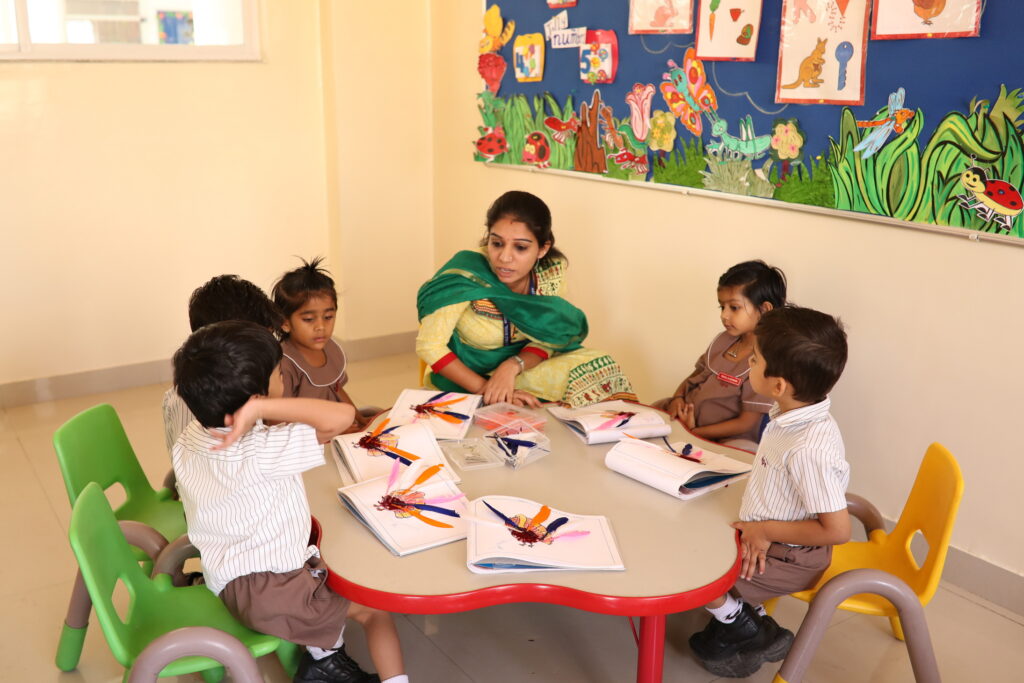
The Art and Craft Programme
The integration of art education with academic subjects at NPS Kengeri fosters the growth of creativity and critical thinking abilities. It teaches pupils to think creatively and develop original answers. The study of the arts improves pupils’ communication skills and teaches them how to do so effectively.
Students in the primary grades are assigned specific topics and challenged to imagine and produce artistic or craft items. Students must use precise drawings, forms, and colours that are true to nature or the specified subject to illustrate the theme. Students comprehend the value of arts and crafts activities and how creativity supports all of their academic disciplines.
Senior students can create imaginative crafts including paper crafts, puppet shows, and sculptures to communicate their feelings and thoughts. They create intricate models that are relevant to many curriculum subjects and precisely draw schematics to help the students realise that art and craft activities are not just for fun but also help them learn crucial skills.
The psychological, emotional, financial, and even the personality-shaping benefits of art are numerous. Because of this, art has always been vital in the world.
Sick Bay
Maintaining a dedicated infirmary with a qualified nurse available during all school hours is a crucial component of ensuring the well-being and safety of our students. This facility provides immediate access to essential healthcare services, offering timely attention to minor ailments and injuries. Having a trained medical professional on-site not only brings comfort to both students and parents but also guarantees a swift and knowledgeable response in case of any medical concerns. This commitment to health and safety underscores our school’s dedication to providing a secure and nurturing environment for every student.
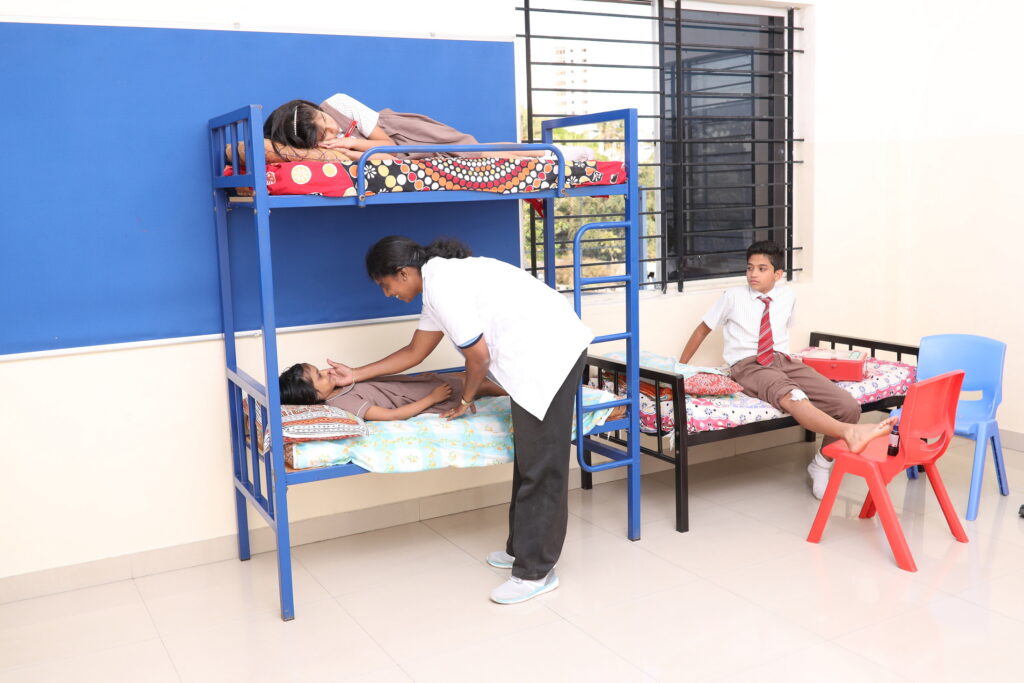
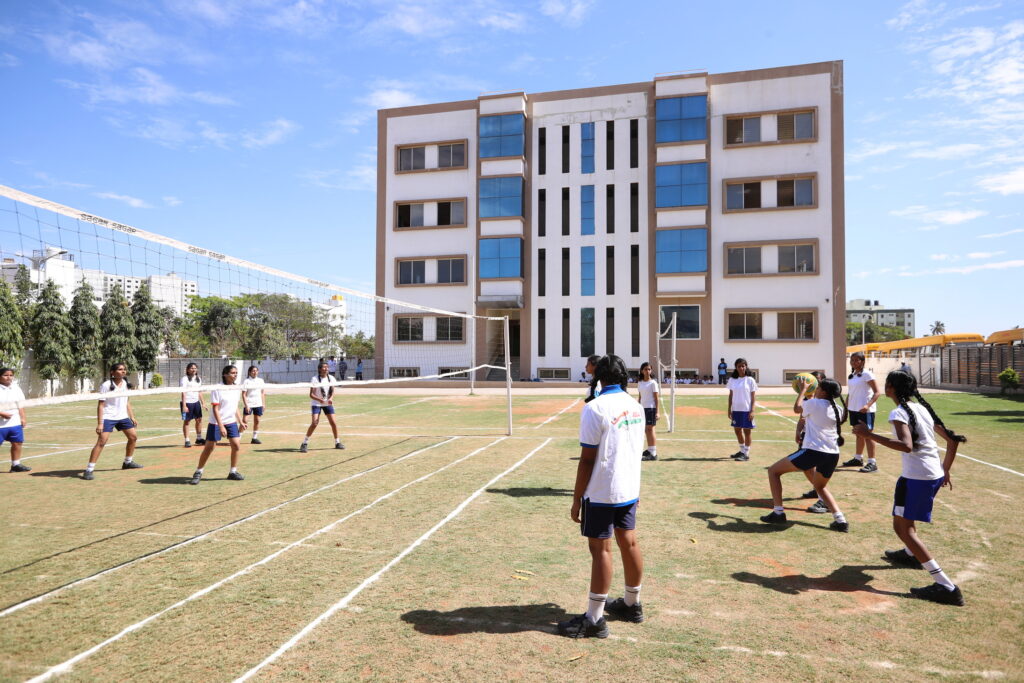
Sports and Physical Education
NPS recognizes that sport is an essential skill that fosters not only fitness but also important values of team-building, sportsmanship and endurance. Physical Training (PT) is an integral part of our curriculum. By providing numerous opportunities for physical education and sports competition. It provides the opportunity for all students to enhance their physical and mental health, hone their individual skills and learn to collaborate through team play.
The sports department believes that the school sports programme should offer a nurturing environment. A variety of outdoor and indoor sports with a age appropriate games offered at the school. Our ground is equipped for cricket, football, volley ball, long jump, throw ball and athletics.
A cement court is laid down for basket ball and two indoor shuttle badminton courts. Facilities for indoor games lie chess, carom, table tennis, etc are also a part in bringing about student’s ‘A healthy mind in a healthy body’. As the bell rings the PT classes are concluded with a energy packed class thereby ready with a punch to their academics.
Guidance and Counselling
Qualified and experienced counsellor provides assistance for children with respect to learning, emotional and behavioural differences / difficulties observed in school. The children are referred to the counsellor by the class teachers and a preliminary assessment of the situation is made. Help is offered in terms of counselling and guiding students and parents. The counsellor also suggest suitable interventional remedies to handle difficulties. The capability and the outreach of the counsellor in the school are limited to an initial assessment of the issue.
